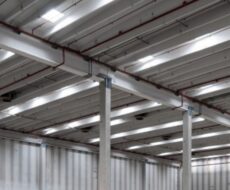
November 19, 2022
The differences between seismic improvement and seismic retro-fitting of warehouses
Although at first glance the terms are very similar, the difference between improvement interventions and seismic retro-fitting interventions is not inconsequential.
These are quite substantial factors, from the cost of implementation to the complexity of the intervention.
The evaluation of these differences is necessary when deciding which intervention to do on a warehouse.
Argomenti

What is the difference between improvement and seismic retro-fitting for pre-fabricated buildings
Let’s list the main differences between these two types of interventions:
Complexity of the project
Designing a seismic improvement intervention in the company is generally relatively limited, as it only includes the parts of the warehouse that are reinforced.
As regards the seismic retrofitting of a warehouse, however, the project is relatively more complex, since it includes the entire building on which work is being done. Specifically, the project must refer to the entire construction and must include both local checks of the individual elements, even if they affect relatively limited portions of the structure, and those of the entire post-intervention structure.
Type of intervention
In essence, the retrofitting involves interventions on existing pre-fabricated structures, designed to achieve a level of seismic safety comparable to more recent buildings, achieving the highest level of safety possible based on the provisions of the legislation.
The improvement is instead a reduction in risk expressed as a percentage compared to the mandatory seismic safety level for warehouses built after 2008.
Intervention times
By varying the operational surface, the duration of the intervention also varies.
As regards an anti-seismic improvement intervention on a pre-fabricated building, it generally takes a few weeks of work, while as regards retrofitting it can take several months, if not a year, to carry out a seismic requalification on the entire production activity.
Intervention cost
Since the interventions are of different scope, dimensions and timing, the cost will be proportional to the latter, therefore it follows that anti-seismic retro-fitting is more expensive than improvement, because there will be a much greater amount of work by increasing the surface area of the warehouse on which to intervene.
Are they mandatory?
By law there are some cases for which it is mandatory to carry out seismic retrofitting on your pre-fabricated building.
Seismic retro-fitting is mandatory:
- when buildings must be raised;
- when expansions of existing building must be carried out through works connected therein;
- when the class and/or intended use of the structure changes with an increase in foundation loads of more than 10%;
- when structural interventions are carried out that will transform the previous structure in a significant way, making it effectively different from the previous one;
- when changes to the intended use are made which lead to using class III buildings for school use or class IV.
Seismic improvement is not mandatory:
Seismic improvement is not mandatory and it is possible to carry it out even in cases where the conditions specified for the adaptation are not present.
Knowing the difference between these two types of interventions is useful for understanding which solution is the most suitable if you need to carry out work to improve the level of company safety and be aware of the various degrees of existing safety.
Furthermore, for the interventions previously listed, it is possible to take advantage of the earthquake bonus for manufacturing buildings, a tax deduction equal to 70% of the expense.





